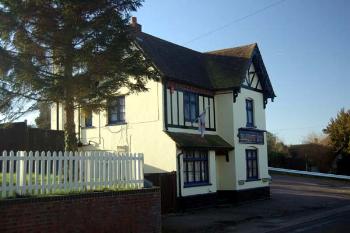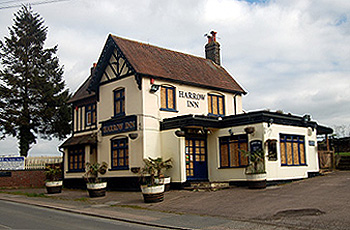The Harrow Public House Woodside

The Harrow, March 2007
The Harrow Public House: 74 Woodside Road
In 1685 a cottage next to Caddington Common formed part of Cantletts Farm [ref: X173/40] and this, by 1787, had become The Harrow Public House [ref: X173/63-65]. It is described as previously in the occupation of Thomas Hadnutt alias Morris, then Robert Ivory and, by 1787, Thomas Keen.
In 1787 the farm, with the Harrow was sold by the heirs of its late owner, George Wilkins, to London butcher John Pope. Pope sold the farm in 1790 and the conveyance [ref: X17370-71] notes that the Harrow had recently been sold separately by Pope, though the purchaser is not named.
By 1835 The Harrow was held by Edward Burr's brewery at Dunstable [ref: BH53]. In 1843 it was one of the licensed premises put up for sale at auction as part of Dunstable Brewery. At that time the property comprised a “capital” club room, a tap room, a washhouse, an underground cellar and three bedrooms. Outside lay a small garden and a yard in front of the house with a wood barn. It was in the occupation of William Keens who paid rent of £8 per annum. A note states: “This lot was purchased by Mr. Edward Burr at the late Hitchin Brewery sale, when the title was investigated; and the title shall therefore commence with the conveyance to him”.
In 1857 the Harrow was sold by Thomas Robert Rackstrow to Ivinghoe [Buckinghamshire] brewer (presumably the purchaser in 1843) to Charles Meacher [ref: RY1045]. The countywide licensing register of 1876 gives the owner as Henry M. Roberts. By the time of the countywide register of 1891 the owner is given as Roberts and Wilson of Ivinghoe. This firm was still the owner listed by the countywide register of 1903. The register describes the public house as in good repair, clean and in a satisfactory sanitary condition. It stood 576 yards from the nearest licensed premises and had both a front and a back door. Roberts and Wilson were bought out by Benskins Watford Brewery in 1927 which was itself bought out by Allied Breweries in 1967. In 1992 Allied merged with Carlsberg becoming Carlsberg-Tetley.
To judge by the appearance of The Harrow it is clearly not a building dating back to the 17th century. Presumably at some point in the past the old building either burned down or was pulled down and today’s property built. To judge by the style of the house this probably took place in the last half of the 19th century or early in the 20th.
The Rating and Valuation Act 1925 specified that every building and piece of land in the country was to be assessed to determine its rateable value. The valuer visiting The Harrow [ref: DV1/C18/75] on 23rd November 1926 noted: "Looks fairly good. Driver says very good little house just the one he should like" although he "couldn't get in when I called at 3.30 pm", he considered that the rates ought to be a bit lower than the Plough. He discovered that the property consisted of a tap room, living room, scullery, bar and parlour downstairs, with a cellar beneath, with three bedrooms above; outside was an old cottage used as a store room, a large workshop "was a stable", a barn and two earth closets, one public. He further noted that "Tenant says she has no idea of trade done or gross takings" - in common with the other licensees in the Caddington area! A note later in the valuer's notebook reads: "Harrow Inn…Sir T[rustram Eve] met Benskins. Trade 80 barrels 7 bottles 40 gallon spirits" as a result of this the rates were actually lowered!
The Harrow remained a public house into the 21st century but by 2012 it had closed.

The former Harrow, March 2012
List of Licensees: note that this is not a complete list. Italics indicate licensees whose beginning and/or end dates are not known:
before 1787: Thomas Hadnutt alias Morris; Robert Ivory;
1787: Thomas Keen;
1822 - 1828: William Keen;
1853: James Matthews;
1857: George Cooke;
1862: Daniel Goodwin
1864: Henry Bigg;
1869: Joshua Dickson;
1872-1873: George Day Church;
1873-1875: Joseph Mayles;
1875: John Newell;
1875: William Cripps;
1875-1876: Frederick Gilbert;
1876-1877: James Brown;
1877-1885: Richard Norton;
1885-1899: Robert Bryant;
1899-1902: William Eyres;
1902-1904: William Frederick Read;
1904-1905: James Frederick Wing;
1905-1906: Reginald Knight;
1909-1942: Maud Knight;
1942-1959: Herbert Walter Bushnell;
1959-1960: Peter Patterson;
1960-1964: Arthur Cyril Wright;
1984-1986: Phillip Ernest Beaumont;
1986-1988: Brian Stanley Lewis;
1988-1991: Mervyn McKenzie;
1991-1992: Roger Bellamy;
1992: Peter George Rayner;
1992: Philip Malcolm William Walters;
1992: Philip Malcolm William Walters and Patrick Bradley Thompson;
1992: David John Jones;
1998: Rex Thomas Draper;
2001: Monty David Penny;
2001: Shirley Anne Littlejohn and Beverley Maud Matthews
Public house closed about 2012.
List of sources at Bedfordshire Archives:
- X173/63-65: Sale of Woodside Farm including The Harrow: 1787;
- X173/70-71: Note of sale of The Harrow: 1790;
- CL/P13: Register of alehouse licences: 1822-1828;
- BH53: Abstract of title of Edward Burr to various premises: 1835;
- BH409: Sale catalogue: 1843;
- RY1045: Conveyed: 1857;
- PSL6/1: Register of Alehouse Licences: 1872-1901;
- PSL6a/1: Register of Alehouse Licences: c.1890-1922;
- PSL6a/2: Register of Alehouse Licences: 1922-1964;
- DV1/C18: Rating valuation: 1927;
- PSL6/2: Register of Alehouse Licences: 1929-1954;
- WW2/AR/CO/3/2: Report of bombs 350 yards south of public house: 1943;
- PCCaddington30/7: Transfer of licence: 1998;
- PCCaddington30/15: Transfer of licence: 2001.